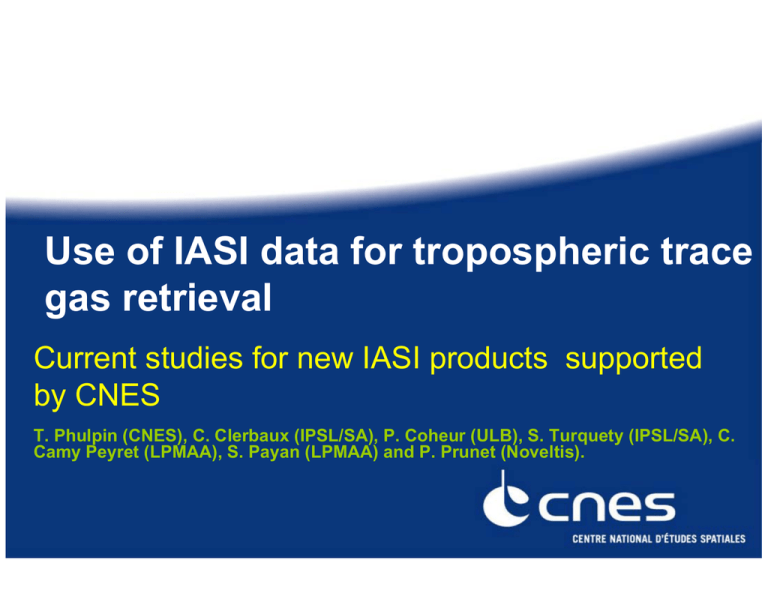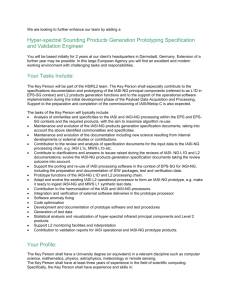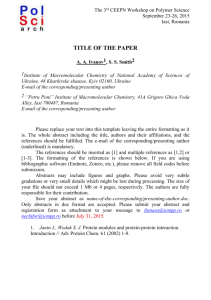Use of IASI data for tropospheric trace gas retrieval by CNES
advertisement

Use of IASI data for tropospheric trace gas retrieval Current studies for new IASI products supported by CNES T. Phulpin (CNES), C. Clerbaux (IPSL/SA), P. Coheur (ULB), S. Turquety (IPSL/SA), C. Camy Peyret (LPMAA), S. Payan (LPMAA) and P. Prunet (Noveltis). GOALS IT IS ESSENTIAL FOR CNES (French space agency) TO DEMONSTRATE THE SOCIETAL BENEFITS OF SPACE PROJECTS LIKE IASI. To foster use of IASI data for meteorology and other areas of application (Climate, air quality monitoring, environment, etc.) by supporting research, distributing high level products and initiating new services. TRYING TO IDENTIFY THE LIMITATIONS (with IASI) TO BE USED IN DEFINITION OF NEXT GENERATION (PEPS) Contribution and support to research - Expand IASI sounding to cloudy pixels (Level1) - Improve current level 2 products - Study additional products - Implement and distribute Level 3 or Level 4 products METOP [2007-2020] IASI - Inversion O3, CO, CH4, N2O,CO2, HNO3, SO2 (volcans), CFCs GOME2 algorithms O3, NO2, SO2, H2CO +Declouding Level 2 Concentrations Global Averaged assimilation Tropospheric chemistry Pollution transport, AQ Emissions Atmospheric spectra Level 3 CTM + Data Level 1 distributions Level 4 Global distributions (multisensors PROCESSING HETEROGENEOUS SCENES (B. Tournier, S. Bijac, O. Lezeaux, P. Prunet) Use of heterogeneous pixels to increase the coverage Benefits : Atmospheric profiles on the edges of frontal systems Reducing integration time and spatial averaging domain for trace gases retrieval (CO2) Issue of spectral shift and pseudo noise due to composition of different spectra at different location within off axis pixels (see P. Schlüssel Poster) IASI heterogeneous scene algorithm Two algorithms are designed Scenes decomposition (studied for Eumetsat) • Suitable for radiances direct assimilation. • The selection of the homogeneous scene to be retrieved is allowed. D and leads • Retrieved scene type can be chosen, suitable for chosen cloudLtype O to cloud parameters retrieval. • Amplification of the noise due to scene decomposition not controlled. • Amplification of the noise due to spectral post calibration. Direct model combination • Suitable for full scene retrieval (all homogeneous components shallW be E considered simultaneously). Needs accurate FRTM for CloudyNpixels and knowledge of surface emissivity spectra • No noise added • System ready for any progress in direct models in the frame of clouds processing. These two approaches are currently under development and will be compared. The most accurate and fast will be implemented for test on a routine basis CO2 Mission specification : Requirements Requirement on the IASI column weighted averaged Boundary layer Boundary layer (pressure) (height) Weight with weighting function Weight with weighting function IASI/SPECTRE IASI/DFT 1013-900 hPa 1.0 km 0.45 0.35 1013-720 hPa 2.7 km 0.77 0.7 Boundary layer Boundary layer (pressure) (height) Required accuracy on mean content (ppmv) Required accuracy on mean content (ppmv) IASI/SPECTRE IASI/DFT 1013-900 hPa 1.0 km 0.9 0.7 1013-720 hPa 2.7 km 1.54 1.4 Required accuracy of about 1 ppmv on the IASI CO2 column weighted averaged High spatial and temporal sampling of IASI Spatial averaging : ~ 1000 measurement points for (103x103) km2 Temporal averaging : 60 measurements/month 5 % of clear data (20 % with cloud-clearing ?) Theoretical noise reduction ratio of about 50 CO2 Data processing : Discrete Fourier Transform (DFT) methodology Selection of 16 specific spectral windows (1282 spectral samples): regions with strong atmospheric CO2 absorption or emission From the quasi periodic line structure of the IASI spectrum re-sampling on a periodic base built from the spectral transitions of the CO2 lines application of a Discrete Fourier Transform to specific spectral windows DFT pseudo data (mean, fundamental and first harmonic) M ea n sig n a l F u n d a m e n ta l F ir st H a r m o n ic TEMPORARY CONCLUSIONS CO2 DFT approach • Permits an efficient extraction of the CO2 information – Filtering the impact of other variables (to be confirmed for surface parameters) – No significant loss of information (to be confirmed near the surface) – Data compression • Gives reliable results on measured noisy data, consistent with independent estimates, showing the robustness of the algorithm Validation on representative sets of data Retrieval accuracy from a single spectrum • • IASI Balloon – 4 ppmv (1 %) on the column averaged mixing ratio – no reliable estimate in low troposphere IASI Metop – 1.2 ppmv (0.3 %) on the column averaged mixing ratio – 20 ppmv (5 %) in low troposphere: information correlated with free troposphere CO2 information from IASI is at the level of mission specifications for a single spectrum Retrievals from simulated data indicate that IASI CO2 product on 3 layers would be more efficient than a column average, in order to exploit the low level information present in the data Remaining to be done :Explore the potential of spatial and temporal averaging Explore the CO2 processing in partially cloudy scenes, in order to separate upper and lower troposphere information THIS GOING TO BE STUDIED IN THE NEXT MONTHS Aerosols Infrared spectra are sensitive to aerosols specially absorbing aerosols like sand dust, volcanic ash and biomass burning Important parameters which can be retrieved from spectra are optical depth and altitude (Pierangelo, 2005) Algorithm developed at LMD and applied to AIRS has been expanded to IASI. A selection of IASI channels dedicated to aerosol has been proposed. TRACE GAS RETRIEVAL FROM IASI Level 2 Processing based on Neural network at stage 1. Those networks have been trained using pseudo IASI spectra simulated from IMG data Alternative inversion method is 1d Var. This method has been used to analyze sensibility of retrievals to various parameters. It will be implemented in a research mode and tested to compare its results with operational retrievals IMG distributions using IASI processing tools (operational mode) Ts O3 CH4 CO + Cloud filtering Hadji-Lazaro et al., GRL 2001 Turquety et al. GRL 2002 Clerbaux et al., ACP 2003 Clerbaux et al., IEEE 1999; JGR 2001 Hadji-Lazaro et al., JGR 1999 SA-Neural network [Turquety et al, JGR 2004] implemented in the Eumetsat ground segment for IASI real-time data processing OZONE Errors Partial columns Vertical profiles 12-24 km Ground-12 km a priori variability total error 40 [O3]retrieved (DU) error sources: smoothing measurement upper-air temperature profile ILS 30 altitude (km) 100 20 Ny Alesund Uccle Hilo Wallops Easter Island Lauder Neumayer 300 75 200 50 50 R = 0.75 bias = 21 % σ = 36 % 25 0 25 50 75 error (%) 100 125 150 100 75 10 0 24-30 km 25 50 75 100 100 R = 0.98 bias = -3 % σ = 10 % 100 200 300 R = 0.93 bias = -1 % σ = 18 % 25 25 50 75 100 [O 3]sondes (DU) Accuracy and precision: ► High for the lower and midlle stratospheric columns ► Good for the tropospheric columns in most cases (bias decreases to 4% partial columns < 25 DU are neglected) [Coheur et al. JGR 2005 ] CARBON MONOXIDE Boundary layer CO (1 km) Upper tropospheric CO (10 km) Pollution Transport Biomass burning Convective transport Good agreement with surface measurements (CMDL network) and model distributions (GEOS-CHEM) [Barret et al. ACPD 2005 ] Nitric Acid (HNO3) Volcanic plumes (SO2) Tb =f (colonne SO2) Sensitivity to level and distribution of SO2 300 1166,5 1168 1367 1370 HIRS ch 12 1166,5 T 1168 T 1367 T 1370 T HIRS 12 T 290 280 270 260 Much stronger at 1350 cm-1 250 If strong amounts a combination of the two bands could be used to retrieve Integrated amount and plume altitude 240 230 220 210 200 0,00E+00 5,00E+02 1,00E+03 1,50E+03 2,00E+03 2,50E+03 3,00E+03 Ecarts avec profil 6 5 0,5 320 320 315 310 310 0 2,5 305 300 300 SO2 *1000 295 290 290 SO2 *1000 9 285 0 -0,5 SO2 500 8 et 9 -2,5 SO2 *250 500 250 -1 280 -5 Tb (K) 275 280 -1,5 270 270 -7,5 265 260 260 -2 255 -10 250 250 -2,5 245 -12 SO2 *E04 240 240 Delta 8-9 5000 5000 235 -3 230 delta 9 10000 230 -15 delta 10 2500 5000 2500 225 Wavenumber (cm-1) 1500 1480 1460 1440 1420 1400 1380 1360 1340 1320 1300 1280 1260 1240 1220 1200 1180 1160 1140 1120 1100 1080 1060 1040 1020 1500 1480 1460 1440 1420 1400 1380 1360 1340 1320 1300 1280 1260 1240 1220 1200 1180 1160 1140 1120 1100 1080 1060 1040 1020 1000 -17 1000 -3,5 220 220 OZONE FROM IR-UV Vertical sensitivity GOME AVK IMG AVK 30 km Altitude (km) 30 20 km 18 km 16 km 14 km 12km 20 10 10 km 1 km 0 -0 .1 0 .0 0 .1 a ve ra g in g ke rn e l 0 .2 0 .3 OZONE PROFILE FROM IR AND UVS SPECTROMETERS (P. Coheur et al.) Taking advantage of multiple instruments ` Synergetic retrievals O3 profile retrieval from IR and UV measurements A GOME → IMG A GOME 40 30 ds 20 UV 3.4 IR 5.4 UV-IR 7.7 10 10 20 30 40 10 20 30 40 Altitude (km) -0.20 -0.12 -0.04 0.04 0.12 0.20 0.28 ` Application to GOME-2 / IASI Solène Turquety, Roeland Van Oss 1/3 CARBON MONOXIDE ASSIMILATION OF CO DERIVED FROM IASI IN A CTM (C. Clerbaux and A. Klonecki) OBSERVATION OPERATOR BASED ON MOPITT DATA STRATEGY DEVELOPEMENT AND TESTS IN LABS BASED FIRST ON SIMULATED DATA AND THEN ON DATA SAMPLES FROM UMARF IMPLEMENTATION IN ROUTINE PSEUDO OPERATIONAL PROCESSING AT CMS FOR LOCAL AT METEO France TOULOUSE FOR GLOBAL OR ON ETHER (National Data Center for Atmospheric chemistry) FACILITIES COMPARISON WITH OTHER GROUPS IN THE FRAMEWORK OF THE ISSWG EITHER IMPLEMENTATION IN THE CGS, THE SAFs OR DISTRIBUTION BY ETHER Conclusions Besides its capacity for atmospheric profiles through assimilation in NWP models, POTENTIAL APPLICATIONS OF IASI ARE NUMEROUS AND MANY ADDITIONAL PRODUCTS ARE TO BE DEVELOPED According to simulations, IASI looks then very promising for greenhouse gases monitoring. Studies are continuing and new topics like cloud properties retrieval, surface parameters are being considered About one year after MetOp launch CNES and Eumetsat organize a Joint Workshop (study conference?) on the first IASI results which will initiate ISSWG phase 2. We hope to see you there!!!



